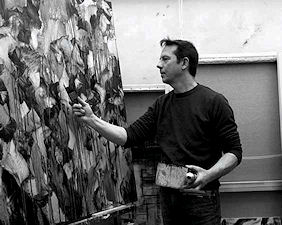Paul Kessling
 It is the hour before dawn on a summer's day deep in the Oxfordshire countryside. The artist has risen in darkness and travelled to this spot just as the first birds are calling. He has ink, brushes and a sheet of white paper before him, damp and stretched flat on a board. There may be only a few moments left before the sun lifts above the horizon and the paper dries too tight to absorb the wet-on-wet colour.
It is the hour before dawn on a summer's day deep in the Oxfordshire countryside. The artist has risen in darkness and travelled to this spot just as the first birds are calling. He has ink, brushes and a sheet of white paper before him, damp and stretched flat on a board. There may be only a few moments left before the sun lifts above the horizon and the paper dries too tight to absorb the wet-on-wet colour.
He works fast, hand moving deftly across the page, brushing in delicate veils of ink. Above the dewy earth floats a pearly pale mist; above that, a band of cerulean blue begins to glow in the sky. In this short interval of intense concentration, Paul Kessling has won a race against time. He has captured the exact transition between darkness and light: the instant of an English daybreak.
Kessling is not just a landscape painter, although the rolling hills and fields where he lives are instantly recognisable in his beautiful pictures. He is a weather man, fascinated by heat, sudden downpour, oncoming storms. He is a poet of the soft shifting light. His smallest paintings, not much bigger than a paperback, are condensed sonnets in praise of the sunset or dawn. But he also works on an epic scale, biblical weather travelling across paintings more than twenty feet square.
Born into the Nineties generation of Emin and Hirst, Kessling is as remote from the short-shock spectacle of Brit Art as he could possibly be. He trained as a sculptor under Eduardo Paolozzi at the Royal College of Art and was on a travelling scholarship to study the Easter Island statues when his career took an unexpected swerve. Kessling hadn¹t much room for materials in his rucksack and had picked up some bottles of ink en route. Back in England, he began to experiment with Japanese brushes and pure cotton paper, finding the true subject for his new technique when he moved to the Oxfordshire countryside.
All his paintings are made outdoors, from the top of his mobile studio: a customised Land Rover with a viewing platform on the roof and compartments for drawing boards inside. In the summer, he is often up at 4am or still working as the light fades at 10pm. Everything he does is conditioned by the weather. Paintings can be rained off at short notice, or worked on for several hours, especially in the winter months, when the moist air keeps the paper from drying.
Kessling¹s art is conditioned by the weather and the light, but also by the inks themselves cobalt, Payne's gray, raw Siena, rose madder, black in several different varieties. Ink is even more volatile than watercolour. The smallest pinprick can blossom into a fast-expanding pool on wet paper. It takes extraordinary sleight of hand to keep the colours from spreading too far or too fast, to preserve the effect of slow-moving weather or the distance between foreground trees and a haze on the far horizon.
But Kessling has that skill. He practices every day, like a virtuoso pianist. With the same brush, he can make the finest of points or a two-inch wide wash. He can track the approaching wind as it blows rain from the clouds in broad swathes; or pinpoint the tiniest crimson embers dying in the transparent twilight. Lately, he has been painting islands; - Lundy, the Scillies - and the mountains of Scotland, where he acknowledges a debt to the Japanese artist Hiroshige. But wherever he is, Kessling's vision is the same: the ever-changing landscape and the great floating world of the sky.
Laura Cumming - Art Critic, Observer September 2002
© 2004 Paul Kessling - All rights reserved.



